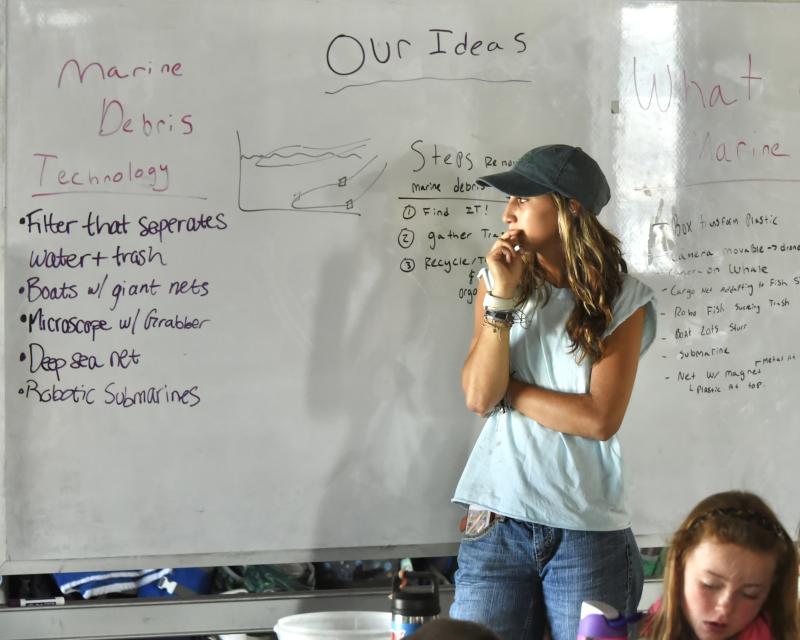
By Carolyn Parker and Annabella Lafond
Our sailors had a great week seven at the Boothbay Sea and Science Center. During the morning our Mizzen sailors spent a lot of time on our Turnabout sailboats and rowboats while splitting their time on land working on their sailing skills. We gave out many “skill beads” last week, as many sailors worked hard to demonstrate their knowledge in knot tying, rigging, de-rigging, tacking, gybing, and sail trim. Our weather on Friday was beautiful, and our youngest sailors got to spend their whole morning on the water sailing in Turnabout sailboats while our more experienced Mizzens spent some time sailing on our Precision 15. Early in the week our Stay’s’l and Top’s’l sailors spent time in Turnabout sailboats exploring Linekin Bay, sailing up to Cabbage Island, as well as working on their skill beads. They also spent a couple of days on our Sonars, Rhodes 19, and Precision 15 as the wind picked up most afternoons, allowing for time on big boats.
The hot weather on Wednesday afternoon was perfect for a swim off our anchored boats at Perch Island. Also, last week our Stay’s’l and Top’s’l sailors spent time at Sherman (Sherm) Brewer Sail Loft learning about how sails are made. They learned about the materials sails are made of, how long it takes to make different types of sails, and they got to see the beginning steps of a sail being made with the sections of fabric being pinned together on the loft’s floor. A huge thank you to Sherm for allowing us into his space and for taking the time to talk to the BSSC sailors and answer all their questions. It was a great week at BSSC, and we are hoping the good weather continues as we head into our penultimate week.
During week seven at Boothbay Sea and Science Center we explored “Lost and Found,” that focused on marine technology and why it’s essential for protecting our oceans. The Great Pacific Garbage Patch is one of the topics our “budding scientists” studied. We also shared our past knowledge challenging common misconceptions while unpacking the truth behind this complex environmental issue. It’s a difficult concept to visualize, but our “budding scientists” rose to the challenge.
We explored how innovative technologies can help restore ocean health and protect marine life, and we talked about what equipment we would design to remove marine debris. Throughout the week, our young “budding scientists” were introduced to real-world examples of marine debris removal tools, sparking their imaginations as they prepared to mockup their own custom solutions. On Friday, our Mizzens proudly showcased their own marine removal creations at our annual Family Friday Cookout. Technologies studied included the Automated Debris Imaging System (ADIS), which uses AI to detect debris, The Interceptor, a device that captures river-borne waste before it reaches the ocean, among several others.
In addition to learning about cutting-edge technology, our budding scientist engaged in a meaningful art project: creating a large mural of the Great Pacific Garbage Patch using marine debris collected from our own bay. This wasn’t just any trash, throughout the summer, students and Instructors have been working together to gather and carefully sort debris from tidal zones. The mural became a powerful, personal statement about the realities of local marine pollution.
On Wednesday, we were excited to welcome guest scientist Kyle Oliveir a visiting PhD Student at Bigelow Laboratory who researches environmental DNA (eDNA) using ocean drifters—devices that float with currents to collect valuable data on ocean movement and marine life. Kyle led a full day of hands-on learning, guiding our budding scientists through the process of building their own drifters. He explained how they function, what types of data they collect, and whether they’re driven more by wind or current. We then tested our creations in Linekin Bay, witnessing science in action as the drifters traveled with the water.
Of course, it wouldn’t be a true Boothbay Sea and Science Center week without fun and games! Our students burned off energy with ocean-themed outdoor activities with Seals and Minnows a favorite. Sailors raced across the bay, laughing and splashing as they teamed up to tag two “minnows” – our Science Instructors. Other popular games included Sailors and Sharks, Fishing, and the Crab Relay, where our students raced to clean up marine debris in a high-energy competition. Our “budding scientist” also got creative with a magnet-making activity, designing their own marine pollution awareness magnets to take home. These games and projects didn’t just provide fun, they reinforced the week’s lessons about ocean stewardship through community, creativity, and action.

